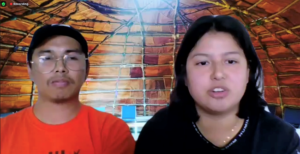Retaining Anishinaabe language and culture under the Anishinabek Nation Governance Agreement key focus of virtual conference

By Rick Garrick
ANISHINABEK NATION TERRITORY – Anishinaabemowin words associated with traditional tasks, a virtual reality Anishinaabemowin teaching tool and an Anishinaabemowin language nest were highlighted at the virtual Retaining Our Language and Culture Under the Anishinabek Nation Governance Agreement conference on Sept. 15.
Taryn Bobiwash, co-founder of the Nimkii Aazhibikong Eshkiniijig (Youth) Group, spoke about the importance of learning Anishinaabemowin words associated with traditional tasks.
“One of the things we were told during the start of our work is that because Anishinaabemowin is so heavily verb based, there’s an entire language and vocabulary associated with our traditional tasks,” Bobiwash says. “So for example with hide tanning, there’s a lot of words that go with specific actions you are doing during the hide tanning process. But if people aren’t hide tanning in their area, then those words are never going to be passed along because you don’t have a chance to interact with them or sometimes even to hear those words. In a lot of cases, when we’re doing these traditional skills seeking out vocabulary associated with the actions we are doing has been a little bit of a challenge, but it’s also been very rewarding to be able to pick up some of those vocabulary words and be able to share with other people who are also beginning these journeys in their own communities.”
Georgian College faculty members Angie King and Michele O’Brien spoke about the college’s virtual reality Anishinaabemowin teaching tool that was developed over the past two years.
“We have four quadrants that we do, one is language in the home, language in the environment, language in the workplace, and language in the community,” King says. “We have students that are using Oculus headsets — they are used for gaming and we use these to teach language.”
O’Brien says they will be having an official launch of the virtual reality Anishinaabemowin teaching tool, which features four virtual worlds based upon Georgian College’s Anishinaabemowin language courses, this month.
“We’re actually willing to give our virtual worlds to any community or organization that would like them,” O’Brien says. “It can be adapted to your own dialect or even your own language, so even if Mohawks wanted to have their language in the virtual worlds they would be able to change that. It’s quite incredible.”
Wiikwemkoong Unceded Territory’s Tracy Recollet-Cleland spoke about the Nawewin Gamig – Wiikwemkoong Language Nest, which started about four years ago with Elders meeting to speak only in Anishinaabemowin in various locations around the community to help people who wanted to learn the language.
“It is a little hard some times because our parents aren’t all fluent — sometimes they have to use a little bit of English to teach them Anishinaabemowin, but it does work,” says Recollet-Cleland, who moved back home about 10 years ago because she wanted to be immersed in Anishinaabemowin. “The focus with Nawewin Gamig is not the parents, it’s the children.”
Recollet-Cleland says Nawewin Gamig rented their own building about two years ago and had two speakers every day from 9 a.m. to 8 p.m. when they first started.
“Our kids now, four are almost fluent,” Recollet-Cleland says. “They understand the language and they can speak the words. I have a set of twins, they’re two-years-old now so they’ve been immersed since I was pregnant right until two-years-old, and right now they pretty much only understand Anishinaabemowin.“
Recollet-Cleland says Nawewin Gamig is not a drop-off centre for children.
“Parents have to be committed,” Recollet-Cleland says. “Parents have to put in that time to show up and bring their kids and sit there like a regular house.”
Under the Anishinabek Nation Governance Agreement, certain provisions of the Indian Act that deal with governance will no longer apply to the ratified First Nations. They will pass their own laws on how they select their Chiefs and Councils; determine who their citizens are without interference from external governments; create laws dedicated to the restoration and preservation of their language and culture; and manage their First Nation government operations.


